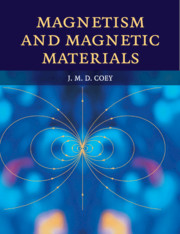Book contents
- Frontmatter
- Contents
- List of tables of numerical data
- Preface
- Acknowledgements
- 1 Introduction
- 2 Magnetostatics
- 3 Magnetism of electrons
- 4 Magnetism of localized electrons on the atom
- 5 Ferromagnetism and exchange
- 6 Antiferromagnetism and other magnetic order
- 7 Micromagnetism, domains and hysteresis
- 8 Nanoscale magnetism
- 9 Magnetic resonance
- 10 Experimental methods
- 11 Magnetic materials
- 12 Applications of soft magnets
- 13 Applications of hard magnets
- 14 Spin electronics and magnetic recording
- 15 Special topics
- Appendices
- Formula index
- Index
- Tables, conversions, constants and units
1 - Introduction
Published online by Cambridge University Press: 05 June 2012
- Frontmatter
- Contents
- List of tables of numerical data
- Preface
- Acknowledgements
- 1 Introduction
- 2 Magnetostatics
- 3 Magnetism of electrons
- 4 Magnetism of localized electrons on the atom
- 5 Ferromagnetism and exchange
- 6 Antiferromagnetism and other magnetic order
- 7 Micromagnetism, domains and hysteresis
- 8 Nanoscale magnetism
- 9 Magnetic resonance
- 10 Experimental methods
- 11 Magnetic materials
- 12 Applications of soft magnets
- 13 Applications of hard magnets
- 14 Spin electronics and magnetic recording
- 15 Special topics
- Appendices
- Formula index
- Index
- Tables, conversions, constants and units
Summary
After a short historical summary, the central concepts of magnetic order and hysteresis are presented. Magnet applications are summarized, and magnetism is situated in relation to physics, materials science and industrial technology.
A brief history of magnetism
The history of magnetism is coeval with the history of science. The magnet's ability to attract ferrous objects by remote control, acting at a distance, has captivated countless curious spirits over two millenia (not least the young Albert Einstein). To demonstrate a force field that can be manipulated at will, you need only two chunks of permanent magnet or one chunk of permanent magnet and a piece of temporary magnet such as iron. Feeble permanent magnets are quite widespread in nature in the form of lodestones – rocks rich in magnetite, the iron oxide Fe3O4 – which were magnetized by huge electric currents in lightning strikes. Priests and people in Sumer, ancient Greece, China and pre-Colomban America were familiar with the natural magic of these magnets.
A lodestone carved in the shape of a Chinese spoon was the centrepiece of an early magnetic device, the ‘South pointer’. Used for geomancy in China at the beginning of our era (Fig. 1.1), the spoon turns on the base to align its handle with the Earth's magnetic field. Evidence of the South pointer's application can be seen in the grid-like street plans of certain Chinese towns, where the axes of quarters built at different times are misaligned because of the secular variation of the direction of the horizontal component of the Earth's magnetic field.
- Type
- Chapter
- Information
- Magnetism and Magnetic Materials , pp. 1 - 23Publisher: Cambridge University PressPrint publication year: 2010

